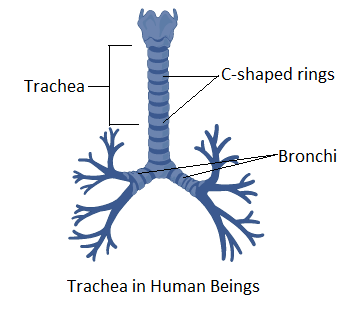
The type of cartilage seen in the tracheal wall is
A. Hyaline cartilage
B. Fibro-cartilage
C. Elastic cartilage
D. None of the above
Answer
459k+ views
Hint: Trachea is a tubular structure that carries air from the nasal cavity to the lungs. It is also called the windpipe. The pharynx and larynx are connected to the lungs through the trachea. It is formed of horseshoe ring-shaped structures. A translucent cartilage tissue surrounds the trachea.
Complete answer:
The trachea is one of the major components of the respiratory system in human beings. It is a tubular structure that connects the pharynx and larynx to the lungs. The trachea begins from the lower edge of the cricoid cartilage of the larynx. It terminates at the carina where the trachea splits into two branches in the lungs called bronchi. It is surrounded by 16 to 20 rings like structures made of translucent cartilage called hyaline cartilage. The hyaline cartilage makes C-shaped rings and is connected to each other by ligaments. These C-shaped rings lie posterior to the trachea. The main function of these rings is to provide support to the trachea and to prevent the collapse of the trachea during inhalation. Hyaline cartilage is also present in the cricoid, thyroid, and arytenoids rings.

Fibro-cartilage is a tough tissue and is very strong in its structure. It is found in the vertebral disks. Elastic cartilage is a highly flexible tissue and capable of bending. It is present in the epiglottis as it needs to bend during swelling so that it covers the windpipe opening.
Therefore, the right answer is option A.
Note: The trachea develops in the fourth week of human embryo development. By the fifth week, the left and the right bronchi begin to form from the terminal ends of the trachea. In adults, the trachea is about 2 centimeters in diameter and has a length of around 10 to 11 centimeters.
Complete answer:
The trachea is one of the major components of the respiratory system in human beings. It is a tubular structure that connects the pharynx and larynx to the lungs. The trachea begins from the lower edge of the cricoid cartilage of the larynx. It terminates at the carina where the trachea splits into two branches in the lungs called bronchi. It is surrounded by 16 to 20 rings like structures made of translucent cartilage called hyaline cartilage. The hyaline cartilage makes C-shaped rings and is connected to each other by ligaments. These C-shaped rings lie posterior to the trachea. The main function of these rings is to provide support to the trachea and to prevent the collapse of the trachea during inhalation. Hyaline cartilage is also present in the cricoid, thyroid, and arytenoids rings.

Fibro-cartilage is a tough tissue and is very strong in its structure. It is found in the vertebral disks. Elastic cartilage is a highly flexible tissue and capable of bending. It is present in the epiglottis as it needs to bend during swelling so that it covers the windpipe opening.
Therefore, the right answer is option A.
Note: The trachea develops in the fourth week of human embryo development. By the fifth week, the left and the right bronchi begin to form from the terminal ends of the trachea. In adults, the trachea is about 2 centimeters in diameter and has a length of around 10 to 11 centimeters.
Recently Updated Pages
Master Class 11 Accountancy: Engaging Questions & Answers for Success

Glucose when reduced with HI and red Phosphorus gives class 11 chemistry CBSE

The highest possible oxidation states of Uranium and class 11 chemistry CBSE

Find the value of x if the mode of the following data class 11 maths CBSE

Which of the following can be used in the Friedel Crafts class 11 chemistry CBSE

A sphere of mass 40 kg is attracted by a second sphere class 11 physics CBSE

Trending doubts
Define least count of vernier callipers How do you class 11 physics CBSE

The combining capacity of an element is known as i class 11 chemistry CBSE

Proton was discovered by A Thomson B Rutherford C Chadwick class 11 chemistry CBSE

Find the image of the point 38 about the line x+3y class 11 maths CBSE

Can anyone list 10 advantages and disadvantages of friction

Distinguish between Mitosis and Meiosis class 11 biology CBSE




